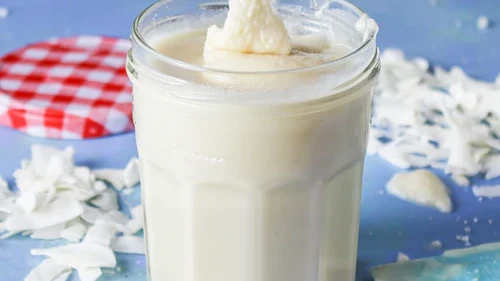Your Cart is Empty

How to make coconut butter at home in a blender
Barb Hodgens
Barb Hodgens loves to cook with alternative, healthy whole food ingredients, with a focus on gut health. Barb has overcome her own gut health issues through healthy eating. Share your ideas, comments and photos at the end of this post :)

Coconut butter plus great ways to use it.
We luv coconut! The Luvele kitchen has developed recipes so that you can make healthier versions of all your favourite coconut products at home. On the recipe blog you can find step by step methods for coconut yogurt, coconut milk and even coconut flour so, it should come as no surprise that we now bring you coconut butter.
Coconut butter, also known as coconut manna, is a creamy spread made from dried coconut. Basically, it’s just pure coconut flesh that has been blended at high speed to become an oily paste. Store-bought coconut butter is a pricy ingredient, so making it at home is very cost effective and it’s easy to do.
Don’t confuse coconut butter with coconut oil. Although similar, coconut oil is a 100 percent oil, whereas the coconut butter has the fibre and other nutrients left in.
The process is much like making homemade peanut or almond butter. Coconut butter however, will not grind completely smooth, so expect it to be a slightly grainy texture. Straight from the blender, while warm, coconut butter is oozy and spreadable. Unfortunately, coconut butter sets solid as it cools. Unless you are in the peak of summer, coconut butter will become hard, dry and crumbly rather than soft and spreadable.
The firm texture is a frustration that leaves people wondering how to use it. The solution is heat. Simply place the jar in hot water or dig out what you need and gently warm in the microwave or saucepan.

Here are some wonderful ways to enjoy coconut butter
- Used it as a nut-free condiment or spread (when it is warm)
- Bake with it – use it in place of of almond butter or any other nut butter in a recipe.
- Stir it into a curry
- The perfect ingredient for making dairy-free, vegan and paleo fudge or fat bombs
- Add a sweetener then coat with dark chocolate
- Add to roasted veggies
- Add to smoothies
- Help make savoury dishes creamier. Lovely in soups and sauces and Asian stir-fries
- Blend it into cake icing and frosting mixture. It helps to set hard.
- Melting it on cooked corn cobs instead of butter
- Cover raisins or nuts, instead of chocolate or yogurt
- Use it instead of cream for your coffee or hot chocolate
- Add it to breakfast porridge to give it a creamy richness
- Eat it straight from the jar
- Use it as an exfoliant on your skin
You can also add in other ingredients to flavour your coconut butter. Adding some cacao powder, cinnamon, or even other nuts can make delicious variations.

Note: it is essential to use the stainless-steal blender jug when making coconut butter.


How to make coconut butter at home in a blender
Luvele
Rated 5.0 stars by 1 users
We luv coconut! The Luvele kitchen has developed recipes so that you can make healthier versions of all your favourite coconut products at home. On the recipe blog you can find step by step methods for coconut yogurt, coconut milk and even coconut flour so, it should come as no surprise that we now bring you coconut butter.
Ingredients
- 6 cups of unsweetened shredded or flaked coconut
- 2 tablespoons coconut oil melted (optional)
Note: it is essential to use the stainless-steal blender jug when making coconut butter.
Directions
- Add the shredded coconut to the stainless-steel Vibe blender jug
Insert the tamper into the lid and then secure it on the jug.
Choose ‘nut’ mode and blend while rotating the tamper and guiding the coconut downwards into the blades for approx. 1 minute.
- Stop, scrape down the sides of the jug and inspect the texture. The main concern with making coconut butter is that some dried coconut will not produce enough oil. If the coconut paste continues to stay dry after 60 minutes blending, add 1-2 tablespoons of coconut oil and then continue blending.
Pour the coconut butter into a jar, seal when it has cooled then store in the pantry.
Coconut butter will last several months.
In cold weather the coconut butter will need to be warmed up before use.
PIN THIS RECIPE

How to make coconut butter at home in a blender

Coconut butter plus great ways to use it.
We luv coconut! The Luvele kitchen has developed recipes so that you can make healthier versions of all your favourite coconut products at home. On the recipe blog you can find step by step methods for coconut yogurt, coconut milk and even coconut flour so, it should come as no surprise that we now bring you coconut butter.
Coconut butter, also known as coconut manna, is a creamy spread made from dried coconut. Basically, it’s just pure coconut flesh that has been blended at high speed to become an oily paste. Store-bought coconut butter is a pricy ingredient, so making it at home is very cost effective and it’s easy to do.
Don’t confuse coconut butter with coconut oil. Although similar, coconut oil is a 100 percent oil, whereas the coconut butter has the fibre and other nutrients left in.
The process is much like making homemade peanut or almond butter. Coconut butter however, will not grind completely smooth, so expect it to be a slightly grainy texture. Straight from the blender, while warm, coconut butter is oozy and spreadable. Unfortunately, coconut butter sets solid as it cools. Unless you are in the peak of summer, coconut butter will become hard, dry and crumbly rather than soft and spreadable.
The firm texture is a frustration that leaves people wondering how to use it. The solution is heat. Simply place the jar in hot water or dig out what you need and gently warm in the microwave or saucepan.

Here are some wonderful ways to enjoy coconut butter
- Used it as a nut-free condiment or spread (when it is warm)
- Bake with it – use it in place of of almond butter or any other nut butter in a recipe.
- Stir it into a curry
- The perfect ingredient for making dairy-free, vegan and paleo fudge or fat bombs
- Add a sweetener then coat with dark chocolate
- Add to roasted veggies
- Add to smoothies
- Help make savoury dishes creamier. Lovely in soups and sauces and Asian stir-fries
- Blend it into cake icing and frosting mixture. It helps to set hard.
- Melting it on cooked corn cobs instead of butter
- Cover raisins or nuts, instead of chocolate or yogurt
- Use it instead of cream for your coffee or hot chocolate
- Add it to breakfast porridge to give it a creamy richness
- Eat it straight from the jar
- Use it as an exfoliant on your skin
You can also add in other ingredients to flavour your coconut butter. Adding some cacao powder, cinnamon, or even other nuts can make delicious variations.

Note: it is essential to use the stainless-steal blender jug when making coconut butter.

:recipekit:
PIN THIS RECIPE

SUBSCRIBE
Sign up to get weekly healthy recipes & information on new product releases.
